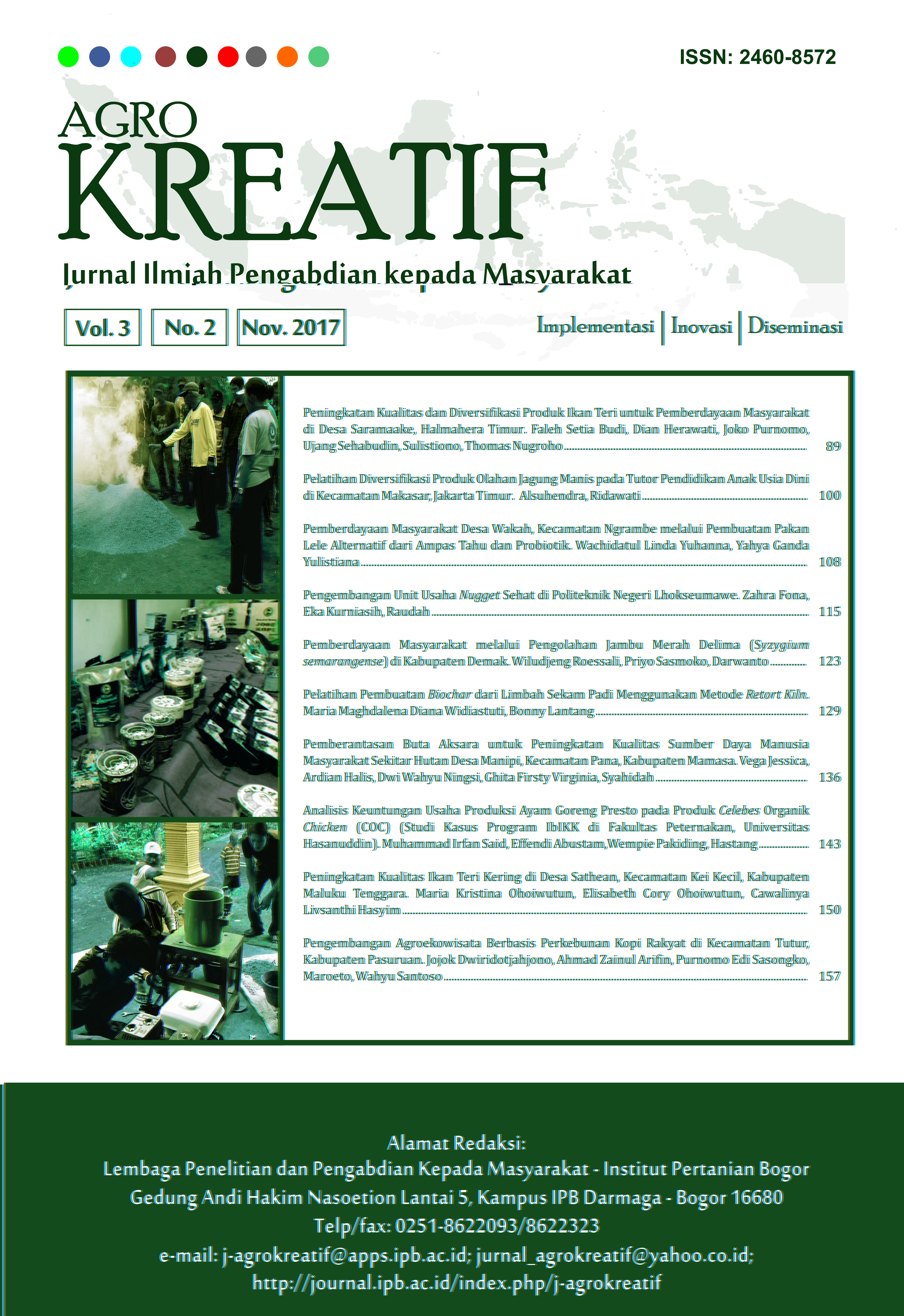Peningkatan Kualitas Ikan Teri Kering di Desa Sathean, Kecamatan Kei Kecil, Kabupaten Maluku Tenggara
Abstract
The business of dry anchovy processing in Sathean Village, Kei Kecil Southeast Maluku was considered as a household scale with traditional open drying methods that potentially lack of hygiene and sanitation, as well as management product, recording and marketing. To overcome this problem, the Perikanan Negeri Tual team of community services was implementing transfer science and technology focusing on building capacity in simple business administration as well as developing manufacture equipment and technique of drying anchovies. There were four program’s activities that conducted, included 1) Initial community education and service; 2) Counseling on hygiene and sanitation of anchovy drying equipment; 3) Extension on simple management of business administration; and 4) Training on manufacturing and technique of anchovy dryer and its production capacity. The output was measured by the achievement of program implementation, and the result was described as follows: 1) The understanding improvement of partners on dry fish processing business, 2) The ability to make a manufacture equipment of anchovy dryers that proved by constructing two dry anchovy dryers with the size p x l x t = 308 x 208 x 250 cm, 3) The capacity to produce 35–40 kg of dried anchovy with hygienic production process, and 4) The skill to manage simple business administration.Downloads
References
Adawyah R. 2008. Pengolahan dan Pengawetan Ikan. Jakarta (ID): PT. Bumi Aksara.
Andik S, Annisa D. 2012. Konsumsi ikan dan hasil pertanian terhadap kadar Hb darah. Jurnal Kemas. 7(2): 110–116.
Arikunto S. 2010. Prosedur penelitian: Suatu Pendekatan Praktik. (Edisi Revisi). Jakarta (ID): Rineka Cipta.
Bartono PH, Rufono EM. 2005. Food Product Management di Hotel dan Restoran. Yogyakarta (ID): Andi Offset.
Blengini GA, Busto M. 2009. Te life cycle of rice: LCA of alternative agri-food chain management systems in Vercelli (Italy). Journal of Environmental Management. 90(3): 1512–1522.
Folinas D, Manikas I, Manos B. 2006. Traceability data management for food chains. British Food Journal. 108(8): 622–633.
Mcmeekin TA, Baranyi J, Bowman J, Dalgaard P, Kirk M, Ross T, Schmid S, Zwietering MH. 2006. Information systems in foodsafety management. International Journal of Food Microbiology. 122(3): 181–194.
Pinem 2004. Proses pengeringan ikan teri. Jurnal Teknik Simetrika. 3: 249–253.
Regattieri A, Gamberi M, Manzini R. 2007. Traceability of food products: General framework and experimental evidence. Journal of Food Engineering. 81(2): 347–356.
Poritosh R, Nei D, Orikasa T, Xu Q, Okadome H, Nakamura N, Shiina T. 2009. A review of life cycle assessment (LCA) on some food products. Journal of Food Engineering. 90(1): 1–10.
Sugiyono. 2013. Metode Penelitian Pendidikan (Pendekatan Kuantitatif, Kualitatif, dan R & D). Bandung (ID): Alfabeta.
Wagacha JM, Muthomi JW. 2008. Mycotoxin problem in Africa: Current status, implications to food safety and health and possible management strategies. International Journal of Food Microbiology. 124(1): 1–12.
This work is licensed under a Creative Commons Attribution-NonCommercial 4.0 International License.



















